Alright, buckle up for the lowdown on keeping your rattan wicker furnuture cushion covers spick and span! We’re diving into the nitty-gritty of maintenance, because, let’s face it, nobody wants dull and drab furniture. Get ready to unleash the secrets to spruce up those cushions and give your space that extra cozy vibe. This article will guide you on how to clean rattan cushion covers step by step.
Let’s roll up our sleeves and discover the hassle-free hacks to keep your wicker furniture cushions looking cool and comfy!
Contents [hide]
1. How to clean rattan cushion covers in washing machine?
Rattan is a natural material commonly used to make chair cushions, sofas, and various other furniture items. Rattan is known for its high durability, lightweight, and ease of maintenance. However, to keep rattan cushions clean and attractive, proper cleaning methods are crucial.
One simple and effective way is to use a washing machine. Here are the steps to clean rattan cushions using a washing machine:
Materials Needed:
- Mild laundry detergent;
- Gentle cycle washing machine;
- Mesh laundry bag or pillowcase;
- Cold water.
Step by step:
Step 1: Remove dust and debris
Vacuum the surface of the rattan cushion using a vacuum cleaner or a soft brush. This helps remove dust, hair, and other debris from the cushion.
Check for any zippers or fastenings securing the cushion to the frame and unzip or release them.
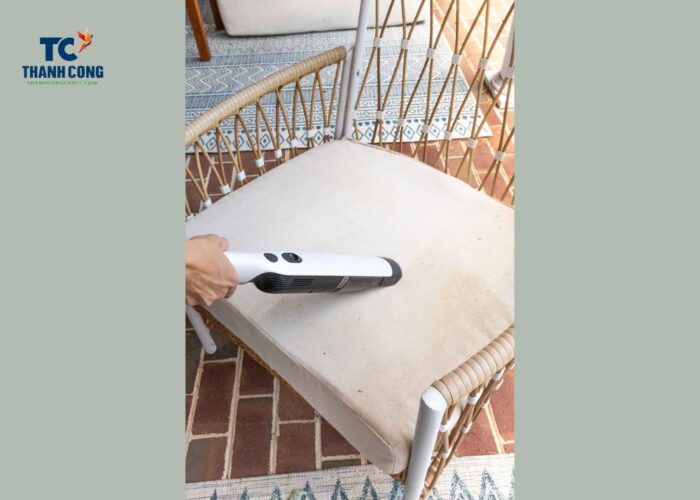
Step 2: Remove the rattan cushion cover
Remove the cushion cover. Do not wash the foam inside the mattress because it is difficult to dry. Instead, dry the foam under the sunlight to remove moisture and prevent mold.
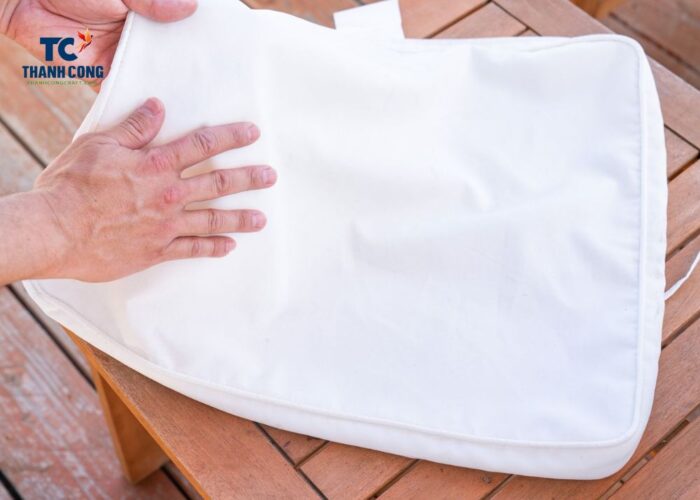
Step 3: Soak and put it in the washing machine
For a thorough cleaning, you can soak your mattress cover in laundry detergent for about 1 hour. If the mattress cover is white, you can use bleaching detergent such as OUT White Brite Laundry Whitener Powder.
Then, put them in the washing machine. Choose a gentle washing cycle and cold water for washing. Hot water can cause the fabric to shrink or lose its color.
When finished washing, take out the cushion.
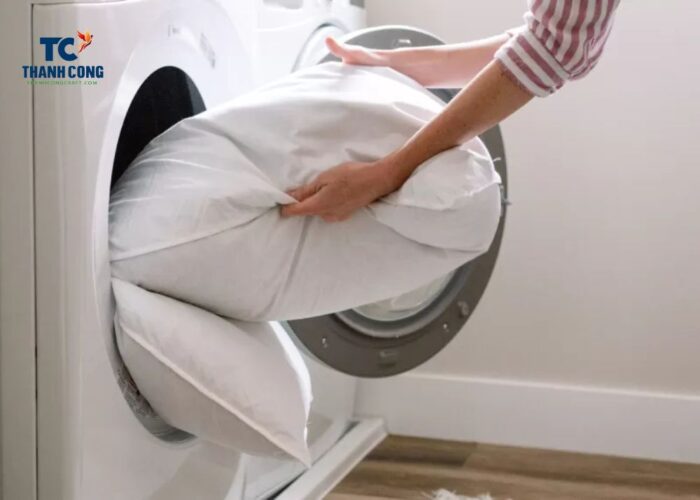
Step 5: Dry the cushion
Air-dry the rattan cushion in a cool, shaded area, avoiding direct sunlight. Flip the cushion to ensure both sides are evenly exposed to air. Once the rattan cushion is completely dry, reassemble it onto the chair or sofa frame. Thus, your cushion cleaning project is completed.
This is a simple and effective method for cleaning chair cushions using a washing machine. Regularly follow these steps to ensure your rattan cushions stay clean and appealing.
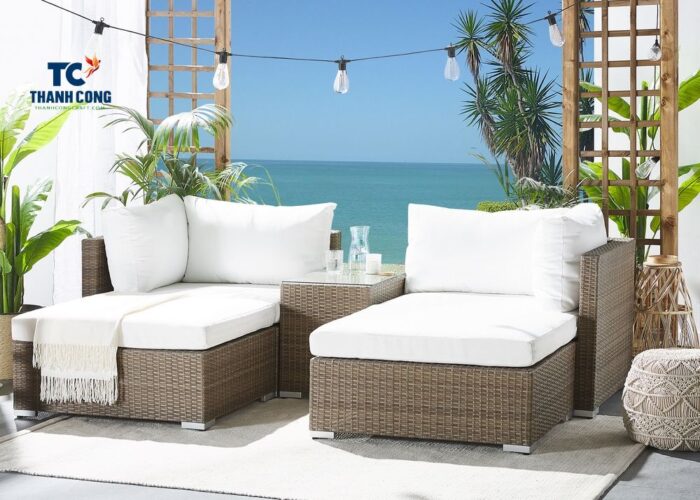
2. How to clean stains from rattan cushion covers?
To clean stains on rattan cushions, you need to prepare a cleaning solution by mixing 1/4 cup of hydrogen peroxide, 1/4 cup of white vinegar, and 2 liters of warm water in a spray bottle. Spray the cleaning solution onto the stain on the cushion and let it soak for 10 minutes.
Use a clean cloth or paper towel to blot and dry the stain. If the stain persists, you can repeat the spraying and blotting process until the stain is completely removed.
Air-dry the rattan cushion in a cool, shaded area, avoiding direct sunlight. Ensure the rattan cushion is fully dry before reattaching it to the chair or sofa frame.
Materials Needed:
- Mild dish soap or laundry detergent;
- Warm water;
- Soft-bristle brush or sponge;
- White vinegar (optional);
- Baking soda (optional);
- Clean cloth or sponge for blotting.
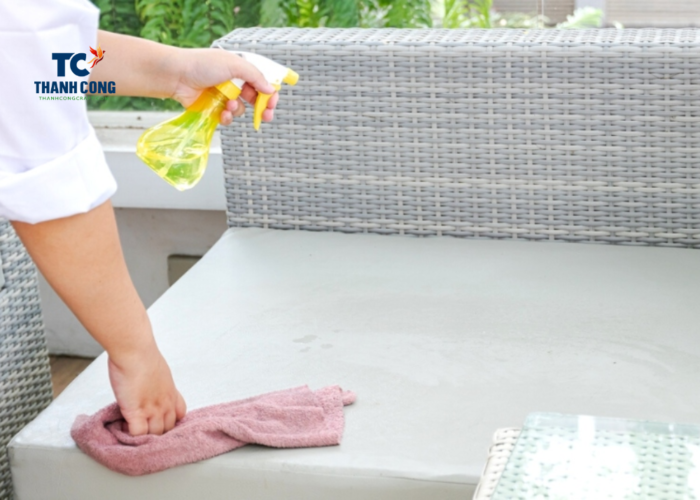
3. How to clean patio cushions with mildew?
Outdoor seat cushions can develop mold if they become damp or are not regularly cleaned. To clean moldy outdoor seat cushions, you’ll need to prepare some tools and materials:
Materials Needed:
- Hydrogen peroxide;
- Dish soap;
- White vinegar;
- Brush;
- Clean cloth.
Here are the steps for cleaning moldy outdoor seat cushions:
Step 1: Spray water on the seat cushions to dampen them and remove any dust.
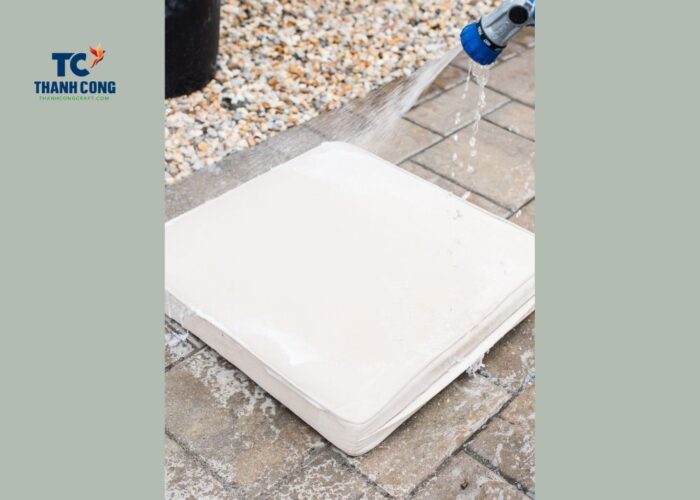
Step 2: Dilute hydrogen peroxide with dish soap in a 1:1 ratio in another spray bottle. Spray this mixture onto the seat cushions, especially on areas with mold.
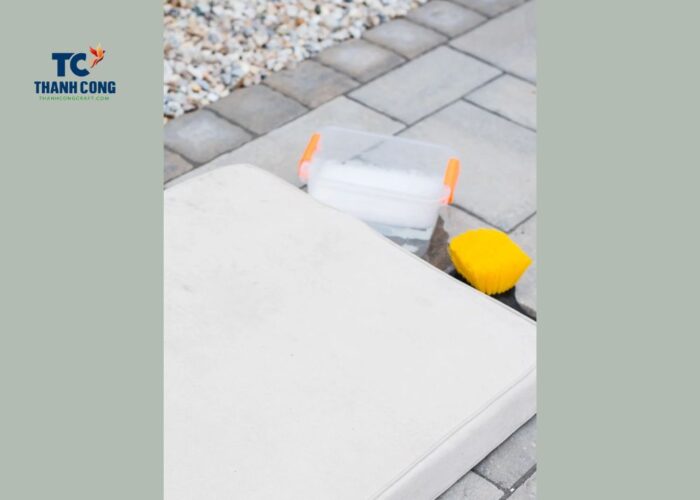
Step 3: Allow the hydrogen peroxide and dish soap mixture to soak into the seat cushions for about 15 minutes. Then, use a brush to gently scrub the areas with mold to clean thoroughly.
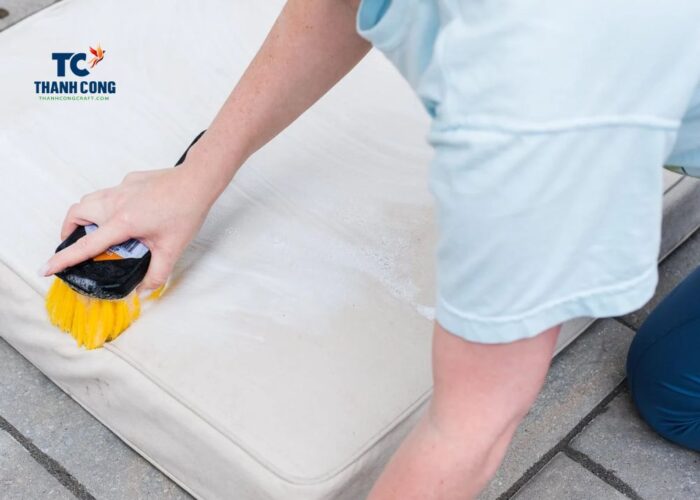
Step 4: Spray white vinegar on the seat cushions to deodorize and disinfect. Let the white vinegar soak into the cushions for about 10 minutes.
Step 5: Spray clean water onto the seat cushions to rinse off the hydrogen peroxide, dish soap, and white vinegar mixture. Use a clean cloth to blot the cushions dry.
Step 6: Air-dry the seat cushions in a sunny location to ensure they are completely dry. Avoid leaving the cushions damp to prevent mold from recurring.
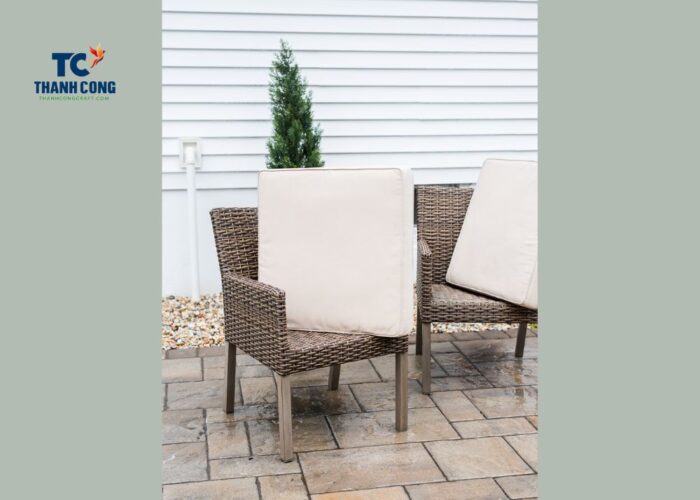
This is a simple and effective way to clean moldy outdoor seat cushions. It’s recommended to perform this cleaning at least once a month to maintain cleanliness and comfort for your outdoor seat cushions.
4. FAQs
4.1 Can rattan cushions get wet?
Rattan is a natural material made from various climbing plants such as rattan palms, bamboo, reed, or willow. Rattan is known for its high durability, excellent load-bearing capacity, and flexibility to be molded into various shapes. It is commonly used in the production of furniture such as chairs, tables, beds, or cushions. However, rattan also has some limitations, especially when it comes into contact with water.
Rattan cannot withstand prolonged exposure to moisture, as it can lead to mold growth, warping, or even breakage. When placed outdoors, it needs protection from rain, snow, or frost. If used indoors, it should be kept away from water sources such as bathtubs, sinks, or washing machines. If rattan becomes wet, it should be dried quickly and placed in a well-ventilated area.
4.2 Can you leave rattan cushions outside overnight?
Leaving rattan cushions outside overnight is not recommended. Rattan is a natural material that can be adversely affected by outdoor elements such as dew, rain, or humidity. Prolonged exposure to moisture can lead to mold, mildew, or damage to the rattan fibers, diminishing the cushions’ quality and lifespan.
To maintain the integrity of rattan cushions, it is advisable to store them indoors or in a covered area when not in use. This protection helps prevent issues related to moisture, ensuring that the cushions remain in good condition over time.
4.3 What is the best cleaner for outdoor cushions?
For cleaning outdoor cushions, the choice of cleaner depends on the type of fabric and specific stains. A simple solution is to use water and mild soap. Mix a few drops of mild soap in a bucket of water and use a sponge or soft brush to gently scrub the cushions. Then, rinse thoroughly with clean water.
If your cushions have yellow stains due to mold, a mixture of equal parts water and white vinegar can be an effective solution. Apply the mixture to the yellow stains and gently brush. Rinse with water afterward.
Additionally, there are various complex cleaners available on the market specifically formulated for outdoor fabrics. Before using any cleaner, it’s advisable to test it in a small inconspicuous area to ensure it doesn’t cause color changes or harm the fabric.
5. Conclusion
In conclusion, cleaning rattan cushion covers is a straightforward process that can help prolong the life and aesthetic appeal of your furniture. By following the simple steps outlined in this guide, you can maintain the cleanliness and freshness of your rattan cushions, ensuring they remain comfortable and visually pleasing.
Regular cleaning not only removes dirt and stains but also prevents the accumulation of grime, which can contribute to the deterioration of the material over time. Remember to choose appropriate cleaning solutions, test them in inconspicuous areas, and follow care instructions provided by the manufacturer.
With proper care, your rattan cushion covers can continue to enhance your living space, providing a cozy and inviting atmosphere for years to come.
If you have any further questions, don’t hesitate to send thanhcongcraft an email us at info@thanhcongcraft.com or message us at WhatsApp: +84967485411. Hope to serve you soon! Best regard!


